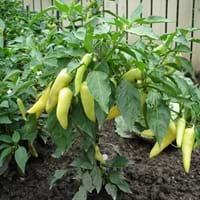Life Span
Biennial and Perennial
Annual
Origin
Europe, Western Asia
Mexico, Central America, South America
Types
Not Available
Sweet Banana Pepper, Banana Bill Hybrid Pepper, Hot Banana Pepper, Inferno Hot Banana Hybrid Pepper
Habitat
waste ground, wastelands
Warmer regions
USDA Hardiness Zone
4-9
9-11
Sunset Zone
A1, A2, A3, H1, H2, 1a, 1b, 2a, 2b, 3a, 3b, 4, 5, 6, 7, 8, 9, 10, 11, 12, 13, 14, 15, 16, 17, 18, 19, 20, 21, 22, 23, 24
A1, A2, A3, H1, H2, 1a, 1b, 2a, 2b, 3a, 3b, 4, 5, 6, 7, 8, 9, 10, 11, 12, 13, 14, 15, 16, 17, 18, 19, 20, 21, 22, 23, 24
Habit
Rosette/Stemless
Upright/Erect
Flower Color
Yellow
White, Ivory
Flower Color Modifier
Bicolor
Bicolor
Fruit Color
Brown, Black
Light Yellow, Lemon yellow, Yellow green
Leaf Color in Spring
Green
Green, Light Green
Leaf Color in Summer
Green
Dark Green
Leaf Color in Fall
Green
Dark Green, Black
Leaf Color in Winter
Not Available
Green
Plant Season
Summer
Spring, Summer, Fall
Sunlight
Full Sun
Full Sun
The pH of Soil
Neutral
Acidic, Neutral
Soil Drainage
Well drained
Well drained
Bloom Time
Summer
Spring, Summer, Fall, Indeterminate
Tolerances
Drought
Drought
Where to Plant?
Ground, Pot
Container, Ground, Pot
How to Plant?
Seedlings
Seedlings, Stem Planting
Plant Maintenance
Medium
Medium
Watering Requirements
Average Water Needs, Do Not over Water, Keep the ground moist but not water-logged
Over-head watering
In Summer
Lots of watering
Lots of watering
In Spring
Moderate
Moderate
In Winter
Average Water
Average Water
Soil pH
Neutral
Acidic, Neutral
Soil Drainage Capacity
Well drained
Well drained
Sun Exposure
Full Sun
Full Sun
Pruning
Remove damaged leaves, Remove dead branches, Remove dead leaves
Prune after harvesting, Prune in late winter, Prune lower leaves
Fertilizers
All-Purpose Liquid Fertilizer
All-Purpose Liquid Fertilizer
Pests and Diseases
Aphids, Armyworm, Cutworms, Downy mildew, Pitch canker, Red blotch
Red blotch
Plant Tolerance
Drought
Drought
Flowers
Showy
Insignificant
Flower Petal Number
Not Available
Single
Fragrant Bark/Stem
Yes
No
Foliage Texture
Fine
Medium
Foliage Sheen
Matte
Glossy
Attracts
Butterflies
Bees
Allergy
Stomach burn
breathing problems, inflammation in lips, Runny nose, sneezing
Aesthetic Uses
Not Available
Not Available
Beauty Benefits
Blood purifying, Good for skin
Not Available
Environmental Uses
Air purification
Air purification
Medicinal Uses
Aphrodisiac
Digestive disorders, Heart problems, High blood pressure, Inflammation
Part of Plant Used
Root
Fruits
Other Uses
Food for animals, Used as a nutritious food item
Not Available
Used As Indoor Plant
Yes
No
Used As Outdoor Plant
Yes
Yes
Garden Design
Edible, Herb, Vegetable
Container, Edible, Herb / Vegetable, Tropical
Botanical Name
PASTINACA sativa
CAPSICUM annuum 'Park's Sweet Banana Whopper'
Common Name
Parsnip
Banana Pepper, Park's Sweet Banana Whopper Pepper
In Hindi
चुकंदर
केले मिर्च
In German
Pastinake
Banana Pfeffer
In French
Panais
Banana Pepper
In Spanish
Chirivía
banano Pimienta
In Greek
Είδος δαυκίου
Πιπεριά Μπανάνα
In Portuguese
cherivia
Banana pimenta
In Polish
Pasternak
Banana Pepper
In Latin
parsnip
Musa sapientum fixa Pepper
Phylum
Magnoliophyta
Not Available
Class
Magnoliopsida
Not Available
Family
Apiaceae
Solanaceae
Clade
Angiosperms, Asterids, Eudicots
Not Applicable
Tribe
Not Available
Not Available
Subfamily
Not Available
Not Available
Number of Species
Not Available
Not Available
Season and Care of Parsnip and Banana Pepper
Season and care of Parsnip and Banana Pepper is important to know. While considering everything about Parsnip and Banana Pepper Care, growing season is an essential factor. Parsnip season is Summer and Banana Pepper season is Summer. The type of soil for Parsnip is Loam and for Banana Pepper is Loam while the PH of soil for Parsnip is Neutral and for Banana Pepper is Acidic, Neutral.
Parsnip and Banana Pepper Physical Information
Parsnip and Banana Pepper physical information is very important for comparison. Parsnip height is 15.20 cm and width 7.60 cm whereas Banana Pepper height is 55.90 cm and width 45.70 cm. The color specification of Parsnip and Banana Pepper are as follows:
Parsnip flower color: Yellow
Parsnip leaf color: Green
Banana Pepper flower color: White and Ivory
- Banana Pepper leaf color: Green, Light Green
Care of Parsnip and Banana Pepper
Care of Parsnip and Banana Pepper include pruning, fertilizers, watering etc. Parsnip pruning is done Remove damaged leaves, Remove dead branches and Remove dead leaves and Banana Pepper pruning is done Prune after harvesting, Prune in late winter and Prune lower leaves. In summer Parsnip needs Lots of watering and in winter, it needs Average Water. Whereas, in summer Banana Pepper needs Lots of watering and in winter, it needs Average Water.





